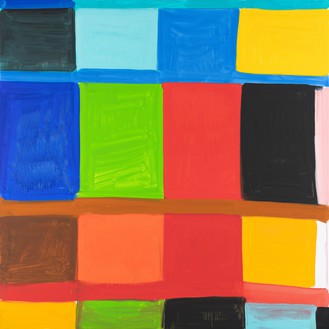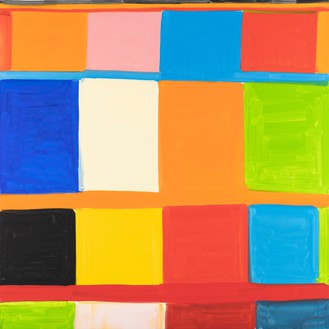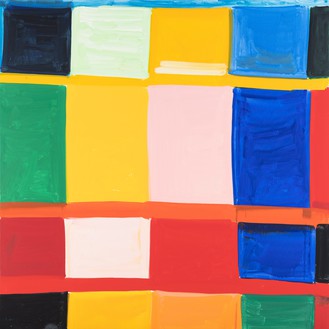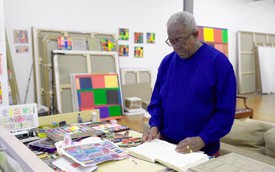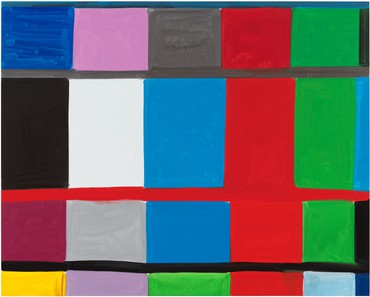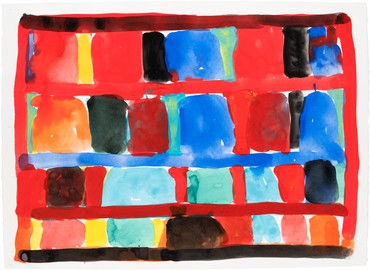About
From June 3, as a preview of Stanley Whitney’s upcoming first exhibition with the gallery later this year, Gagosian Rome is presenting the Bertacca paintings, produced in the artist’s studio near Parma, Italy. These works are on view Monday to Friday, from 11am to 6pm.
Italian art and architecture became an enduring source of inspiration for Whitney when he lived and worked in Italy during the 1990s. The historical facades of the Colosseum and Palazzo Farnese, the stacked shelves of ancient funerary urns at the National Etruscan Museum, and the frescoes of Villa Boscoreale deepened his understanding of the nuanced relationship between structure and color. In 2017, Whitney titled a painting “Bertacca” after the small hamlet outside of Parma, in Emilia-Romagna, where his studio is located. Two years later, he painted Bertacca 1, 2, 3, and 4 as the beginning of an ongoing thread. Each Bertacca painting cites the rich shades of vermilion in the Boscoreale frescoes. The unknown Pompeiian artist’s use of color captured Whitney’s imagination as well as that of Giorgio Morandi, coincidentally from the same region as where Whitney maintains a studio. In Emilian cities like Parma, densely packed residential buildings create unusual color stories. Like Whitney’s bars of paint and Morandi’s forms defined by color rather than line, Parma’s saturated casette vary in proportion and their walls and window shutters parade the same dirty yellows, light pinks, and broken reds.
In anteprima alla mostra di Stanley Whitney a Roma a settembre, la prima con la galleria, dal 3 Giugno Gagosian Roma presenta la serie di dipinti Bertacca, realizzati dall’artista nel suo studio vicino a Parma. Le opere sono visibili dal lunedì al venerdì, dalle 11 alle 18.
L’arte e l’architettura italiana diventano una fonte di ispirazione duratura per Whitney durante il soggiorno in Italia degli anni ’90. La contemplazione dal vivo delle facciate storiche del Colosseo e di Palazzo Farnese, delle antiche urne funerarie presso il Museo Nazionale Etrusco e degli affreschi di Villa Boscoreale hanno fatto in modo che Whitney approfondisse la sua comprensione del rapporto complesso tra struttura e colore. Nel 2017 Whitney ha intitolato un dipinto Bertacca, dal nome del piccolo borgo fuori Parma dove si trova il suo studio. Due anni dopo, ha dipinto Bertacca 1, 2, 3 e 4 dando inizio ad una serie. Ogni dipinto di Bertacca cita le ricche sfumature di vermiglio negli affreschi di Boscoreale. L’uso del colore da parte dell’anonimo artista Pompeiano cattura l’immaginazione di Whitney e Morandi. La serie Bertacca è stata dipinta nello studio di Whitney alle porte di Parma, la stessa regione in cui Morandi ha vissuto e lavorato per tutta la vita. In questa città emiliana, edifici residenziali, costruiti gli uni vicino agli altri, creano insolite composizioni di colore. Come i blocchi di pittura di Whitney, le sature case parmigiane variano nelle proporzioni e le loro pareti e persiane sfoggiano gli stessi gialli sbiaditi, rosa chiari e rossi sospesi.
Lavorando energicamente, Whitney dipinge con vigore le tele di circa 2 metri per 2 metri tracciando con tocco sfumato sottili strati di pittura ad olio ispirati alle calde tonalità dell’Emilia-Romagna. In Bertacca 3, un opaco latte cosmico—noto agli scienziati come il colore dell’universo—è contrastato da toni accesi di arancione chiaro, verdi elettrici e toni di blu cobalto riccamente strutturati. Ad uno sguardo più attento, i limiti di questi colori diventano meno distinti. Una pennellata di latte cosmico scivola sul vicino cobalto, velando i suoi toni più scuri. Mentre le delicate sfumature di Morandi sfocano i confini tra oggetti e spazio, Whitney crea bordi con accordi cromatici così definiti da imporsi sul campo pittorico.Variazioni di trama all’interno di ogni blocco mantengono vive le sue pennellate, creando un linguaggio ritmico personale e costruendo, quasi letteralmente, una finestra sulla sua relazione con il colore che dura da una vita.
A seguito della recente riapertura di Gagosian Roma, la galleria ha collaborato con La Fondazione alla presentazione di un programma non-stop dal lunedì al venerdì.
I dipinti della serie Bertacca di Whitney sono esposti dal lunedì al venerdì, dalle 11 alle 18. Alla porta accanto, La Fondazione completa questa programmazione con una presentazione di opere video realizzate da artisti contemporanei italiani, dalle 18 alle 11 del mattino del giorno seguente.
#StanleyWhitney
Stanley Whitney: Rhythm and Vision
While preparing his first exhibition with Gagosian, in Rome, Stanley Whitney speaks with Louise Neri in his New York studio about how he arrived at his unique and intuitive approach to color and space in painting, employing a dynamic fusion of preordained structure and improvisation.

Stanley Whitney: Vibrations of the Day
Stanley Whitney invited professor and musician-biographer John Szwed to his studio on Long Island, New York, as he prepared for an upcoming survey at the Buffalo AKG Art Museum to discuss the resonances between painting and jazz.
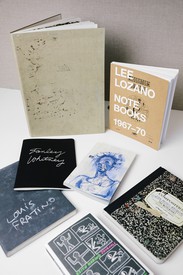
Book Corner
Private Pages Made Public
Megan N. Liberty explores artists’ engagement with notebooks and diaries, thinking through the various meanings that arise when these private ledgers become public.
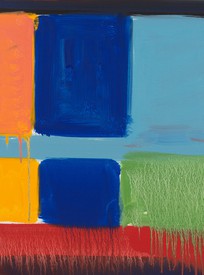
The Space Is in the Color: Stanley Whitney
Stanley Whitney reflects on the evolution of his work with Louise Neri, from his formative early days in New York to the pivotal period he spent living and working in Rome, arriving at the highly distinctive paintings for which he is now known. They explore the diverse and surprising influences of art and music on Whitney’s oeuvre, as well as his process and practice.
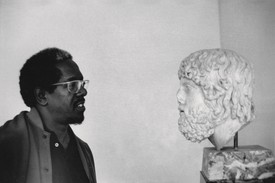
Stanley Whitney: The Ruins
For American painter Stanley Whitney, Italy remains a central and enduring source of inspiration. Matthew Jeffrey Abrams, the author of a new monograph on the artist, reflects on the profound and far-reaching influence of Italian art and architecture on Whitney’s art.
News
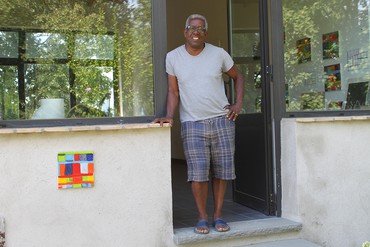
In Conversation
Stanley Whitney
Matthew Jeffrey Abrams
Thursday, October 15, 2020, 2pm EDT
In the context of Stanley Whitney’s exhibition of recent paintings at Gagosian, Rome, which closes on October 17, Whitney and author Matthew Jeffrey Abrams will discuss Abram’s new monograph on the artist and the diverse formative influences on the artist’s imagination. To join, register at zoom.us.
Stanley Whitney at his studio near Parma, Italy, 2012. Photo: Marina Adams, courtesy the artist
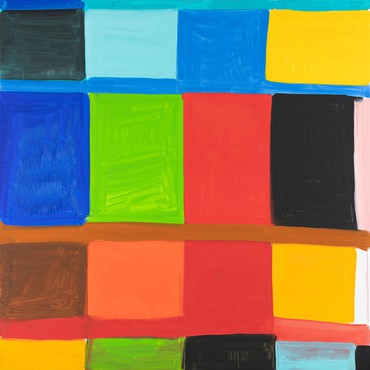
Collaboration
Gagosian Rome
& La Fondazione
June 3–September 2020
Rome
As a preview to Stanley Whitney’s upcoming exhibition at Gagosian Rome later this year, the gallery is presenting the Bertacca paintings, produced in his studio near Parma, Italy. Whitney’s experiences in Italy, where he lived during the 1990s and where he maintains a working studio, remain a constant source of enrichment for his art. As a complementary project, each week La Fondazione is presenting the work of a contemporary Italian artist born in the 1980s or 1990s, visible to passersby through the building’s glass doors, daily from 6pm to 11am.
Download the full press release in English (PDF) or Italian (PDF)
Stanley Whitney, Bertacca 2, 2019 © Stanley Whitney. Photo: Giorgio Benni
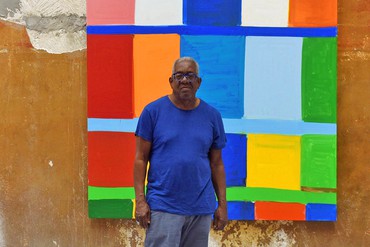
Artist Spotlight
Stanley Whitney
April 15–21, 2020
Stanley Whitney has been deeply invested in chromatic experimentation throughout his career, but it was the experience of Italian art and architecture, both ancient and modern, that informed his unique understanding of the nuanced relationship between color and geometry. His highly dynamic abstract paintings unlock the grid, imbuing it with new and unexpected cadences of color, rhythm, and space. Deriving inspiration from sources as diverse as Sandro Botticelli and Piet Mondrian, free jazz and American quilt-making, Whitney composes in varying scales with vibrant blocks and bars that articulate a chromatic call-and-response within each canvas.
Photo: EFE/Alamy
